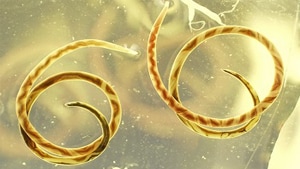Key points
- Angiostrongylus is a parasite found in rats. It is also called rat lungworm.
- People can get infected by eating raw or undercooked snails or slugs that are infected with this parasite.
- Most people infected with rat lungworm recover on their own without treatment.
More Information

Overview
Angiostrongylus cantonensis is a parasitic worm of rats. It is also called the rat lungworm. The adult form of the parasite is found only in rodents. Infected rats pass larvae of the parasite in their feces. Snails and slugs get infected by ingesting the larvae. These larvae mature in snails and slugs but do not become adult worms. The life cycle is completed when rats eat infected snails or slugs and the larvae further mature to become adult worms.
Species
Angiostrongylus cantonensis, which is also known as the rat lungworm, causes eosinophilic meningitis and is prevalent in Southeast Asia and tropical Pacific islands. The recognized distribution of the parasite has been increasing over time and infections have been identified in other areas, including Africa, the Caribbean, and the United States.
Angiostrongylus costaricensis causes eosinophilic gastroenteritis and is found in Latin America and the Caribbean.
Symptoms
Some infected people don’t have any symptoms—or have only mild symptoms that don’t last very long. Sometimes the infection causes a rare type of meningitis (eosinophilic meningitis). The symptoms can include headache, stiff neck, tingling or painful feelings in the skin, low-grade fever, nausea, and vomiting.
How it spreads
People can get infected by eating raw or undercooked snails or slugs that are infected with this parasite. In some cultures, snails are commonly eaten. Some children, in particular, have gotten infected by swallowing snails/slugs "on a dare. " People also can get infected by accident, by eating raw produce (such as lettuce) that contains a small snail or slug or part of one.
Certain animals such freshwater shrimp, crabs, or frogs, have been found to be infected with larvae of the parasite. African land snails, which can grow larger than a person’s hand, is just one of many types that can be infected. But snails can be infected only if they have ingested contaminated rat feces.
It is possible that eating undercooked or raw animals that are infected could result in people becoming infected, though the evidence for this is not as clear as for eating infected snails and slugs. Of note, fish do not spread this parasite.
Prevention
Don’t eat raw or undercooked snails or slugs, frogs or shrimp/prawns. If you handle snails or slugs, wear gloves and wash your hands. Always remember to thoroughly wash fresh produce. When travelling in areas where the parasite is common, avoid eating uncooked vegetables.
Testing and diagnosis
See your healthcare provider, who will examine you and ask about any symptoms, travel, and exposures you’ve had (for example, to snails/slugs). You might have some blood tests, as well as tests for meningitis.
Treatment
The parasite dies over time, even without treatment. Even people who develop eosinophilic meningitis usually don’t need antiparasitics. Sometimes the symptoms of the infection last for several weeks or months, while the body’s immune system responds to the dying parasites. The most common types of treatment are for the symptoms of the infection, such as pain medication for headache or medications to reduce the body’s reaction to the parasite, rather than for the infection itself. Patients with severe cases of meningitis may benefit from some other types of treatment.
